Ao Huang
Movable-Element STARS-Assisted Near-Field Wideband Communications
May 25, 2025Abstract:A novel movable-element simultaneously transmitting and reflecting surface (ME-STARS)-assisted near-field wideband communication framework is proposed. In particular, the position of each STARS element can be adjusted to combat the significant wideband beam squint issue in the near field instead of using costly true-time delay components. Four practical ME-STARS element movement modes are proposed, namely region-based (RB), horizontal-based (HB), vertical-based (VB), and diagonal-based (DB) modes. Based on this, a near-field wideband multi-user downlink communication scenario is considered, where a sum rate maximization problem is formulated by jointly optimizing the base station (BS) precoding, ME-STARS beamforming, and element positions. To solve this intractable problem, a two-layer algorithm is developed. For the inner layer, the block coordinate descent optimization framework is utilized to solve the BS precoding and ME-STARS beamforming in an iterative manner. For the outer layer, the particle swarm optimization-based heuristic search method is employed to determine the desired element positions. Numerical results show that:1) the ME-STARSs can effectively address the beam squint for near-field wideband communications compared to conventional STARSs with fixed element positions; 2) the RB mode achieves the most efficient beam squint effect mitigation, while the DB mode achieves the best trade-off between performance gain and hardware overhead; and 3) an increase in the number of ME-STARS elements or BS subcarriers substantially improves the system performance.
STAR-RIS Assisted SWIPT Systems: Active or Passive?
Dec 23, 2024



Abstract:A simultaneously transmitting and reflecting reconfigurable intelligent surface (STAR-RIS) assisted simultaneous wireless information and power transfer (SWIPT) system is investigated. Both active and passive STAR-RISs are considered. Passive STAR-RISs can be cost-efficiently fabricated to large aperture sizes with significant near-field regions, but the design flexibility is limited by the coupled phase-shifts. Active STAR-RISs can further amplify signals and have independent phase-shifts, but their aperture sizes are relatively small due to the high cost. To characterize and compare their performance, a power consumption minimization problem is formulated by jointly designing the beamforming at the access point (AP) and the STAR-RIS, subject to both the power and information quality-of-service requirements. To solve the resulting highly-coupled non-convex problem, the original problem is first decomposed into simpler subproblems and then an alternating optimization framework is proposed. For the passive STAR-RIS, the coupled phase-shift constraint is tackled by employing a vector-driven weight penalty method. While for the active STAR-RIS, the independent phase-shift is optimized with AP beamforming via matrix-driven semidefinite programming, and the amplitude matrix is updated using convex optimization techniques in each iteration. Numerical results show that: 1) given the same aperture sizes, the active STAR-RIS exhibits superior performance over the passive one when the aperture size is small, but the performance gap decreases with the increase in aperture size; and 2) given identical power budgets, the passive STAR-RIS is generally preferred, whereas the active STAR-RIS typically suffers performance loss for balancing between the hardware power and the amplification power.
Enhancing User Fairness in Wireless Powered Communication Networks with STAR-RIS
Oct 02, 2024Abstract:A simultaneously transmitting and reflecting reconfigurable intelligent surface (STAR-RIS) assisted wireless powered communication network (WPCN) is proposed, where two energy-limited devices first harvest energy from a hybrid access point (HAP) and then use that energy to transmit information back. To fully eliminate the doubly-near-far effect in WPCNs, two STAR-RIS operating protocol-driven transmission strategies, namely energy splitting non-orthogonal multiple access (ES- NOMA) and time switching time division multiple access (TS- TDMA) are proposed. For each strategy, the corresponding optimization problem is formulated to maximize the minimum throughput by jointly optimizing time allocation, user transmit power, active HAP beamforming, and passive STAR-RIS beamforming. For ES-NOMA, the resulting intractable problem is solved via a two-layer algorithm, which exploits the one-dimensional search and block coordinate descent methods in an iterative manner. For TS-TDMA, the optimal active beamforming and passive beamforming are first determined according to the maximum-ratio transmission beamformer. Then, the optimal solution of the time allocation variables is obtained by solving a standard convex problem. Numerical results show that: 1) the STAR-RIS can achieve considerable performance improvements for both strategies compared to the conventional RIS; 2) TS- TDMA is preferred for single-antenna scenarios, whereas ES- NOMA is better suited for multi-antenna scenarios; and 3) the superiority of ES-NOMA over TS-TDMA is enhanced as the number of STAR-RIS elements increases.
STAR-RIS Assisted Downlink Active and Uplink Backscatter Communications with NOMA
Mar 22, 2024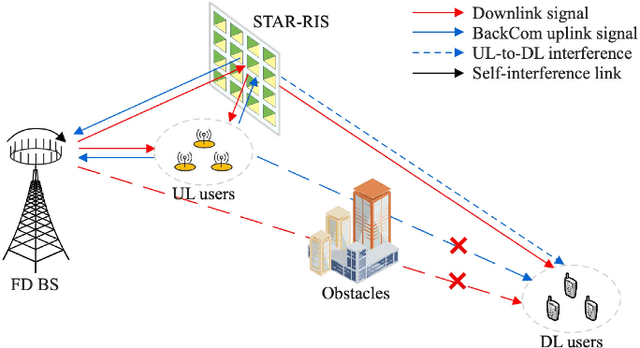
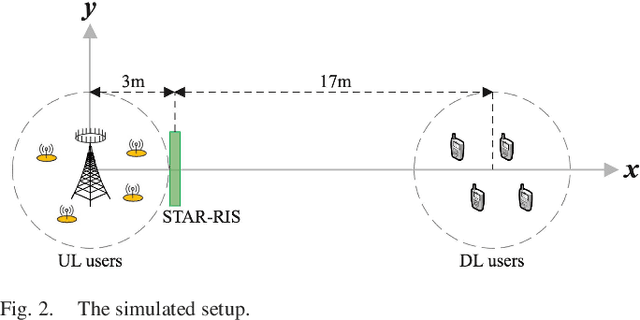
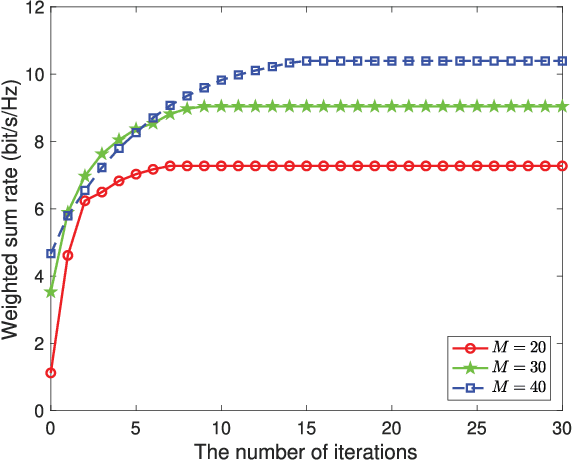
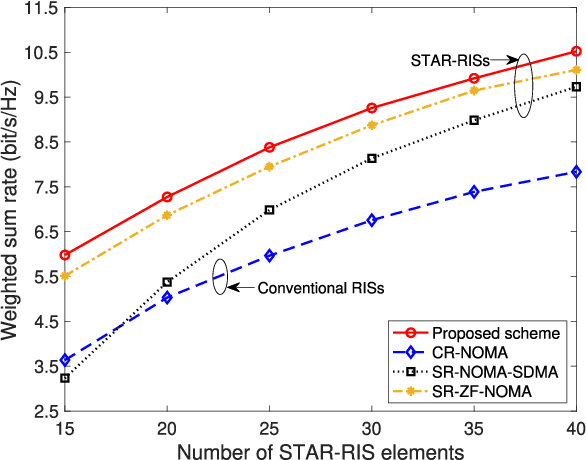
Abstract:A simultaneously transmitting and reflecting reconfigurable intelligent surface (STAR-RIS) assisted downlink (DL) active and uplink (UL) backscatter communication (BackCom) framework is proposed. More particularly, a full-duplex (FD) base station (BS) communicates with the DL users via the STAR-RIS's transmission link, while exciting and receiving the information from the UL BackCom devices with the aid of the STAR-RIS's reflection link. Non-orthogonal multiple access (NOMA) is exploited in both DL and UL communications for improving the spectrum efficiency. The system weighted sum rate maximization problem is formulated for jointly optimizing the FD BS active receive and transmit beamforming, the STAR- RIS passive beamforming, and the DL NOMA decoding orders, subject to the DL user's individual rate constraint. To tackle this challenging non-convex problem, we propose an alternating optimization (AO) based algorithm for the joint active and passive beamforming design with a given DL NOMA decoding order. To address the potential high computational complexity required for exhaustive searching all the NOMA decoding orders, an efficient NOMA user ordering scheme is further developed. Finally, numerical results demonstrate that: i) compared with the baseline schemes employing conventional RISs or space division multiple access, the proposed scheme achieves higher performance gains; and ii) higher UL rate gain is obtained at a cost of DL performance degradation, as a remedy, a more flexible performance tradeoff can be achieved by introducing the STAR-RIS.
Robust Resource Allocation for STAR-RIS Assisted SWIPT Systems
Mar 22, 2024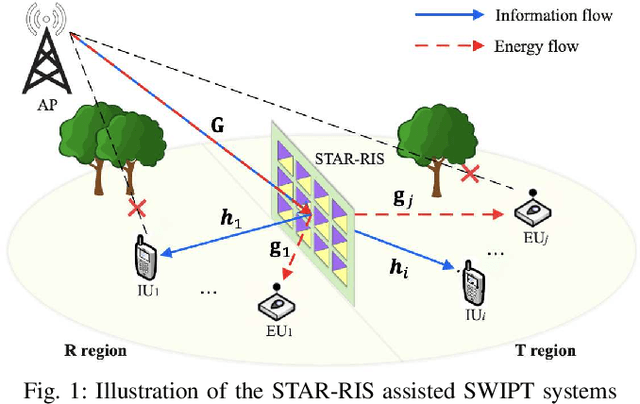
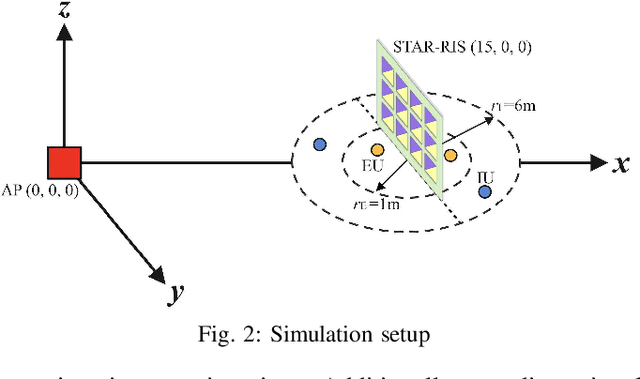
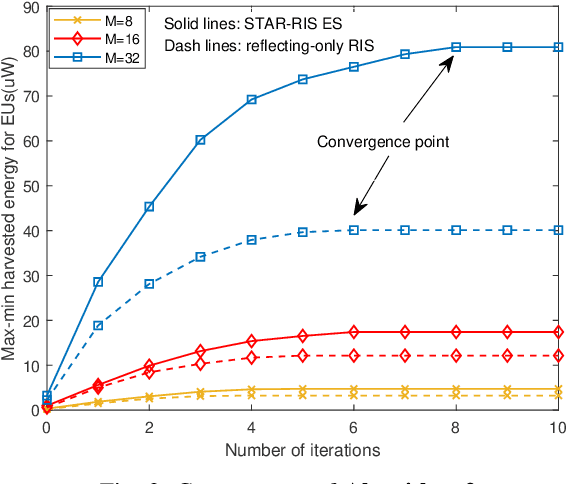
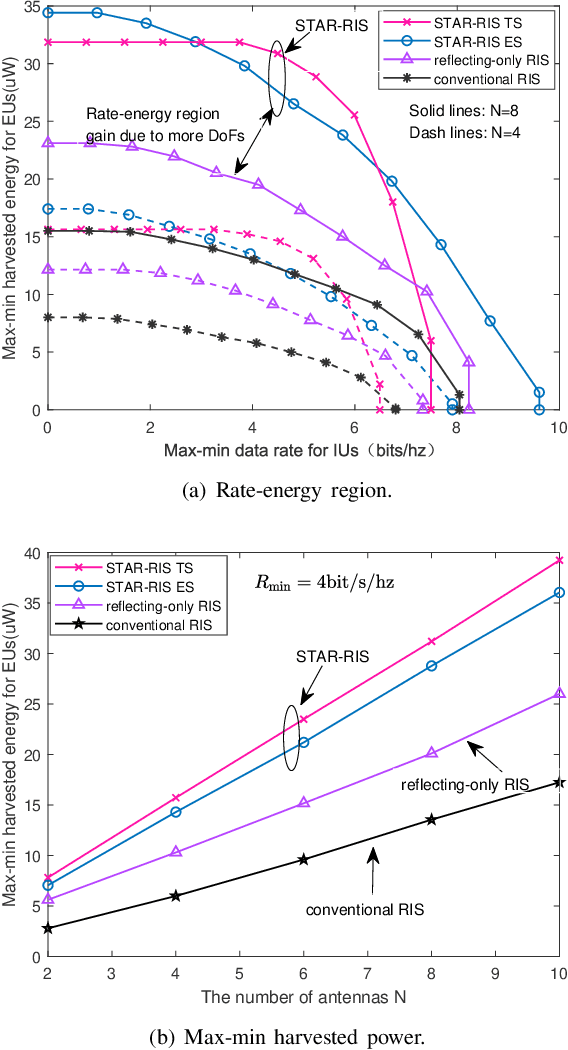
Abstract:A simultaneously transmitting and reflecting reconfigurable intelligent surface (STAR-RIS) assisted simultaneous wireless information and power transfer (SWIPT) system is proposed. More particularly, an STAR-RIS is deployed to assist in the information/power transfer from a multi-antenna access point (AP) to multiple single-antenna information users (IUs) and energy users (EUs), where two practical STAR-RIS operating protocols, namely energy splitting (ES) and time switching (TS), are employed. Under the imperfect channel state information (CSI) condition, a multi-objective optimization problem (MOOP) framework, that simultaneously maximizes the minimum data rate and minimum harvested power, is employed to investigate the fundamental rate-energy trade-off between IUs and EUs. To obtain the optimal robust resource allocation strategy, the MOOP is first transformed into a single-objective optimization problem (SOOP) via the {\epsilon}-constraint method, which is then reformulated by approximating semi-infinite inequality constraints with the S-procedure. For ES, an alternating optimization (AO)-based algorithm is proposed to jointly design AP active beamforming and STAR-RIS passive beamforming, where a penalty method is leveraged in STAR-RIS beamforming design. Furthermore, the developed algorithm is extended to optimize the time allocation policy and beamforming vectors in a two-layer iterative manner for TS. Numerical results reveal that: 1) deploying STAR-RISs achieves a significant performance gain over conventional RISs, especially in terms of harvested power for EUs; 2) the ES protocol obtains a better user fairness performance when focusing only on IUs or EUs, while the TS protocol yields a better balance between IUs and EUs; 3) the imperfect CSI affects IUs more significantly than EUs, whereas TS can confer a more robust design to attenuate these effects.
Coexisting Passive RIS and Active Relay Assisted NOMA Systems
Mar 22, 2024
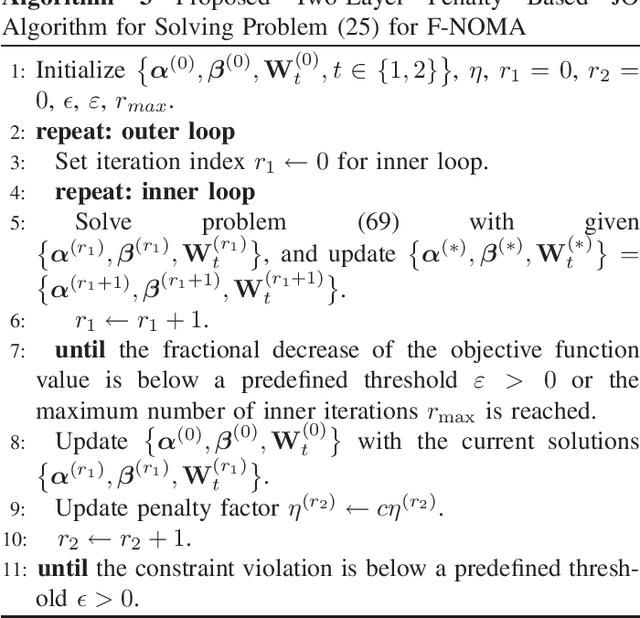
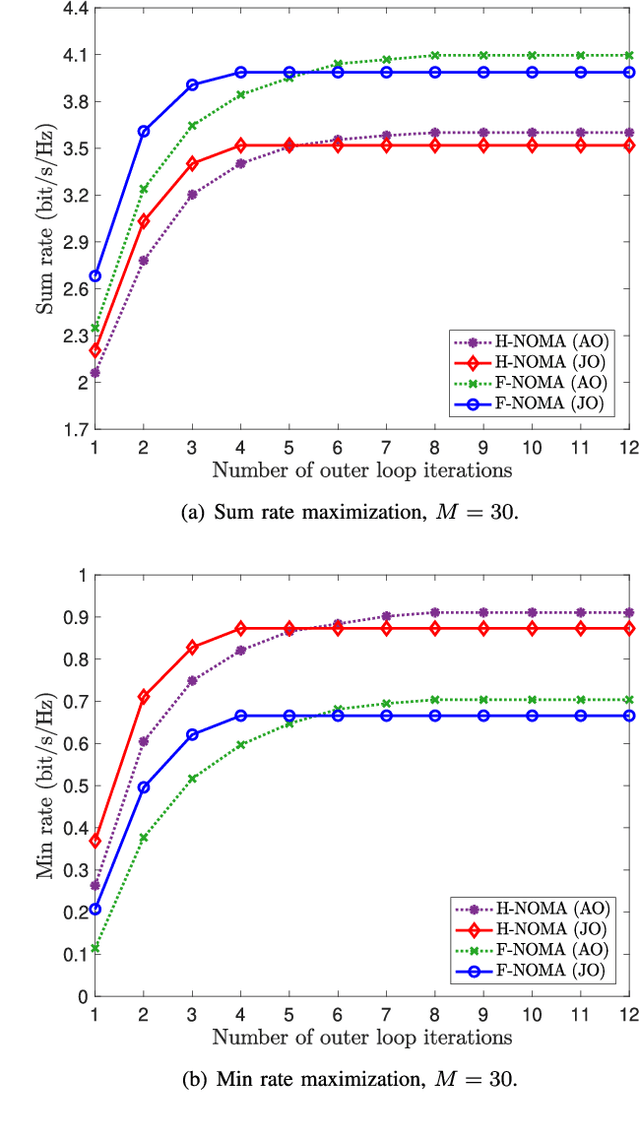
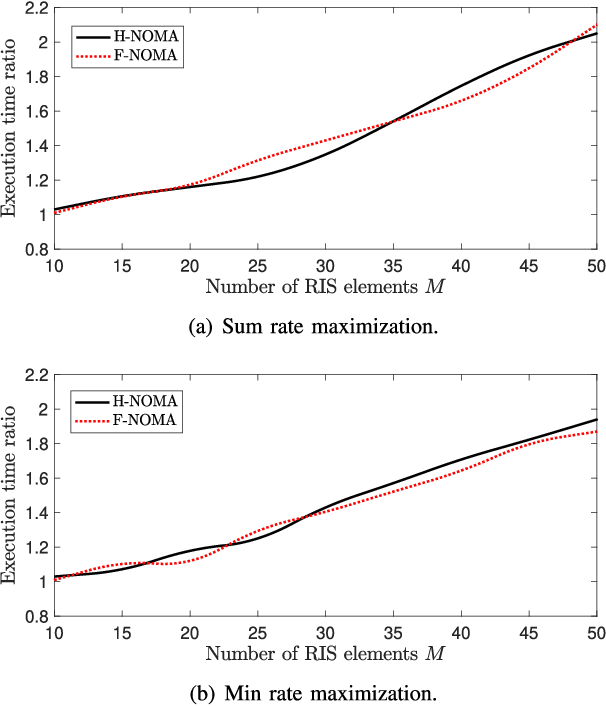
Abstract:A novel coexisting passive reconfigurable intelligent surface (RIS) and active decode-and-forward (DF) relay assisted non-orthogonal multiple access (NOMA) transmission framework is proposed. In particular, two communication protocols are conceived, namely Hybrid NOMA (H-NOMA) and Full NOMA (F-NOMA). Based on the proposed two protocols, both the sum rate maximization and max-min rate fairness problems are formulated for jointly optimizing the power allocation at the access point and relay as well as the passive beamforming design at the RIS. To tackle the non-convex problems, an alternating optimization (AO) based algorithm is first developed, where the transmit power and the RIS phase-shift are alternatingly optimized by leveraging the two-dimensional search and rank-relaxed difference-of-convex (DC) programming, respectively. Then, a two-layer penalty based joint optimization (JO) algorithm is developed to jointly optimize the resource allocation coefficients within each iteration. Finally, numerical results demonstrate that: i) the proposed coexisting RIS and relay assisted transmission framework is capable of achieving a significant user performance improvement than conventional schemes without RIS or relay; ii) compared with the AO algorithm, the JO algorithm requires less execution time at the cost of a slight performance loss; and iii) the H-NOMA and F-NOMA protocols are generally preferable for ensuring user rate fairness and enhancing user sum rate, respectively.
Hybrid Active-Passive RIS Transmitter Enabled Energy-Efficient Multi-User Communications
Mar 04, 2024



Abstract:A novel hybrid active-passive reconfigurable intelligent surface (RIS) transmitter enabled downlink multi-user communication system is investigated. Specifically, RISs are exploited to serve as transmitter antennas, where each element can flexibly switch between active and passive modes to deliver information to multiple users. The system energy efficiency (EE) maximization problem is formulated by jointly optimizing the RIS element scheduling and beamforming coefficients, as well as the power allocation coefficients, subject to the user's individual rate requirement and the maximum RIS amplification power constraint. Using the Dinkelbach relaxation, the original mixed-integer nonlinear programming problem is transformed into a nonfractional optimization problem with a two-layer structure, which is solved by the alternating optimization approach. In particular, an exhaustive search method is proposed to determine the optimal operating mode for each RIS element. Then, the RIS beamforming and power allocation coefficients are properly designed in an alternating manner. To overcome the potentially high complexity caused by exhaustive searching, we further develop a joint RIS element mode and beamforming optimization scheme by exploiting the Big-M formulation technique. Numerical results validate that: 1) The proposed hybrid RIS scheme yields higher EE than the baseline multi-antenna schemes employing fully active/passive RIS or conventional radio frequency chains; 2) Both proposed algorithms are effective in improving the system performance, especially the latter can achieve precise design of RIS elements with low complexity; and 3) For a fixed-size hybrid RIS, maximum EE can be reaped by setting only a minority of elements to operate in the active mode.
 Add to Chrome
Add to Chrome Add to Firefox
Add to Firefox Add to Edge
Add to Edge